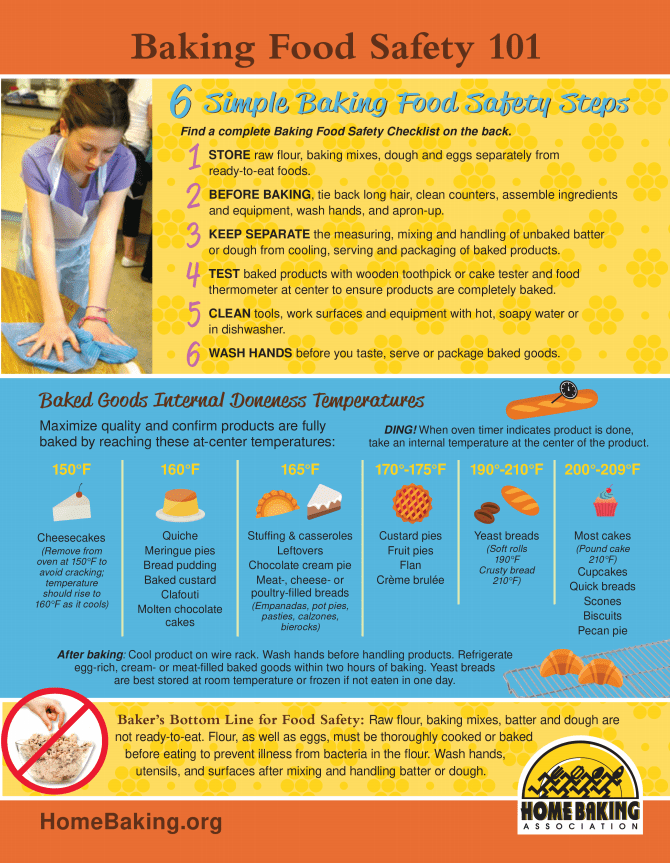Cooking is a great hobby. What other activity do you do that you get to eat what you make? But sometimes even the best of intentions can run amok. We all know somebody who has had food poisoning, but what are some food safety rules that can prevent you and your loved ones from getting sick? Here are a few simple tips and tricks to keep you and the people you love safe from foodborne illness and to learn about the importance of food safety.
Six Steps to Successful, Safe Cooking
The Home Baking Association has broken down proper baking safety into six simple and easy to follow steps! So, what are some dos and don’ts for kitchen safety?
First, store your raw ingredients away from the ready-eat-foods. Your fridge can be a hopping place for bacteria to spread, so put your raw ingredients in sealed containers and prevent the bacteria from escaping.
Second, before you get down to business baking or cooking, be sure to do a scan and wipe down of your workplace. Make sure your countertops and tools are clean and ready for food to be prepared. And for folks with a full head of hair, be sure to tie your hair up so no hair ends up in your masterpiece. You want people to enjoy what you made, not get scared off by a hair!
Third, be sure to separate the raw ingredients you are preparing from the finished product packing area. You do not want the germs from your raw materials to get in with the food you just cooked!
Next, try testing your food with a wooden toothpick and food thermometer! These are great methods to make sure your food is cooked thoroughly and to a safe temperature. Every article that focuses on the importance of food safety recommend a food thermometer for a reason. It’s really easy to under cook or under bake your food items… Don’t fall into salmonella’s trap!
Fifth, use hot soapy water to clean your pots and pans. The hot water will kill most of the germs, and the soap will get your dishes squeaky clean.
Finally, the sixth step is -insert your mom’s voice here- wash your hands! Always. When in doubt, wash your hands. Before you cook, as you go along, and then after you are done. Wash often and wash with hot water and soap.
By following these simple steps, you can keep your family, your friends and yourself safe from pathogens and foodborne illness!

Dough Dilemma
We all do it. You are whipping up your favorite batch of chocolate chip cookies. The smells are so sweet and you can practically taste the finished product already! That cookie dough looks soooo good. One itty bitty bite won’t hurt anyone! WRONG. Back away and put the dough down. Raw cookie dough contains both raw eggs and raw flour. Both of these products can cause illnesses in their raw state, but they will become safe to eat as the product bakes. Thanks, heat! Be patient and wait for the cookies to be fully cooked before indulging in them. Don’t worry! The wait will be worth it! Have you washed your tools and hands, yet?
Prepping Pro
Placing importance on food safety should be a habit that reaches from ingredient-gathering all the way to final food packing. Try cracking eggs into a separate small bowl to avoid getting accidental egg shell pieces in your batter. There is no shame is using two different cutting boards! If you have some ready-to-eat foods give them a fresh clean cutting board, and if you have some raw products, be sure to have a whole new cutting board ready. Scrape any scraps into the garbage just to keep any particles from having contact with cooked and prepared food.
If you take anything away from this article, raw and prepared foods should not meet up.
Be the Best Baker and Focus on the Importance of Food Safety!
It is game time…. Or I should say bake time! This is the time to put to the test all the tips and tricks we have offered. Let your food cool on wire racks and not on counter tops, and keep those racks away from places where you had raw products. Test your food by using the toothpick or thermometer. Just because the outside looks done, does not always mean the food is actually cooked through! If you use an egg wash, make sure you apply it before putting the food in the oven. It will help get that golden brown color that is appetizing, and it will cook off any pathogens that could be in the egg wash.
With these tips and tricks in your cooking tool belt, you are all set to go out and make sure your food is safe AND delicious! Always wash your hands, keep your raw food and ready-to-eat food separated, keep your area clean and again, wash your hands. Go ahead — have your (baked) cake and eat it too, all without getting sick!
Our friends at the Home Baking Association have a handy baking safety checklist to have on hand! Be sure to Fight Bac and print a few out and give them to your kiddos as you cook. It’s never too early to develop good food safety habits!
Now that you’ve got some great tips on the importance of food safety in YOUR kitchen, why don’t you take a second to learn where that food you are safely handling comes from? Take a look at life on the Ochs’ Farm, a family in south west Kansas, during wheat harvest! Or, want some tips from a registered dietitian on how to help your kids love the kitchen? We’ve got you covered!